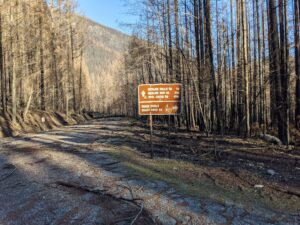 Anyone who pays taxes or recreates on national forests in Oregon should support the U.S. Forest Service’s efforts to remove dead and dying trees that pose safety hazards to the public. In the face of liability concerns, failure to act means the agency will be forced to close forest roads where hazard trees are found.
Anyone who pays taxes or recreates on national forests in Oregon should support the U.S. Forest Service’s efforts to remove dead and dying trees that pose safety hazards to the public. In the face of liability concerns, failure to act means the agency will be forced to close forest roads where hazard trees are found.
Choosing not to mitigate hazard trees will result in reduced access to public lands to most Americans. And because public agencies will not send firefighters into dangerous situations, the reduction of forest roads means firefighters will not be able to quickly access and attack a fire before it burns out of control.
It is estimated 377,000 acres of national forests burned in last year’s wildfires, according to Forest Service Rapid Assessment Team reports. Criticism of roadside hazard tree removal seems disingenuous given the fact the Forest Service has not proposed salvage of dead and dying trees outside of roadside areas. In fact, an overwhelming amount of burned forests will be left untouched.
Even if the agency successfully mitigates roadside hazards, one will only have to look a little farther to see thousands of acres of dead and dying trees left to stand and fall. Some of this downed material will serve as fuel for future wildfires. A good example are designated Wilderness areas where forest management is off-limits, and where new fires often reburn in scars filled with dead trees from past fires.
Without post-fire management, which includes quick salvage and reforestation work, most of these areas will not be replanted with new trees. And some forests may not regenerate naturally without our help due to the impacts of climate change.
These is a case to be made for public agencies to do more to remove dead and dying trees, especially in areas that are suitable for forest management, and where this downed material can be utilized for things we all need and use every day. When dead and dying trees can be processed into wood products, it supports Oregon jobs and can help support wildfire and economic recovery efforts, while providing revenue to agencies to support reforestation work on public lands.
One obstacle to providing affordable housing and rebuilding our communities after last year’s wildfires is the high price of building materials, including lumber that has reached record prices. It is reported that lumber costs have gone up 188 percent since the beginning of the pandemic, adding an estimated $24,000 to the cost of an average single-family home.
Oregon-grown wood products manufacturers are working very hard to increase production and meet this historic demand. However, a factor that is keeping our manufacturers from increasing supply is the lack of timber, burnt or otherwise. This is despite the state’s abundance of federally owned forests that were already in need of proactive management to reduce heavy fuels.
As it stands, builders, contractors and consumers are forced to pay high prices for wood products that are imported from other regions and countries, rather than being sourced and manufactured in Oregon where the carbon footprint for transporting finished lumber is much smaller.
Quick removal of dead and dying trees is often the right thing to do. It maintains public access to public lands for visitors and first responders. It can help provide relief from record costs for building materials. And it provides resources so that we can replant and grow more trees in burned forests. Taking action to mitigate hazards along roadsides is the very least our public agencies can do after the widespread destruction caused by the 2020 wildfires.



